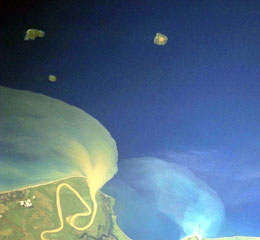Report on Kadovar (Papua New Guinea) — 14 March-20 March 2018
Smithsonian Institution / US Geological Survey
Weekly Volcanic Activity Report, 14 March-20 March 2018
Managing Editor: Sally Sennert.
Please cite this report as:
Global Volcanism Program, 2018. Report on Kadovar (Papua New Guinea) (Sennert, S, ed.). Weekly Volcanic Activity Report, 14 March-20 March 2018. Smithsonian Institution and US Geological Survey.
Kadovar
Papua New Guinea
3.608°S, 144.588°E; summit elev. 365 m
All times are local (unless otherwise noted)
RVO reported that the lava dome at Kadovar’s SE Coastal Vent continued to grow, though slowly, with only a 1-m change detected during 10-20 March. Weak incandescence from the Main Crater was visible on 13 March. Bright incandescence from both the Main Crater and the SE Coastal vent was visible on 14 March, coincident with the start of dark gray ash emissions from both vents, lasting until 19 March.
Geological Summary. The 2-km-wide island of Kadovar is the emergent summit of a Bismarck Sea stratovolcano of Holocene age. It is part of the Schouten Islands, and lies off the coast of New Guinea, about 25 km N of the mouth of the Sepik River. Prior to an eruption that began in 2018, a lava dome formed the high point of the andesitic volcano, filling an arcuate landslide scarp open to the south; submarine debris-avalanche deposits occur in that direction. Thick lava flows with columnar jointing forms low cliffs along the coast. The youthful island lacks fringing or offshore reefs. A period of heightened thermal phenomena took place in 1976. An eruption began in January 2018 that included lava effusion from vents at the summit and at the E coast.
Source: Rabaul Volcano Observatory (RVO)

